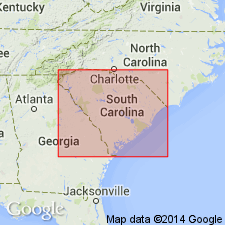
- Usage in publication:
-
- Rhems shale
- Modifications:
-
- Named
- Dominant lithology:
-
- Clay
- Shale
- AAPG geologic province:
-
- Atlantic Coast basin
Summary:
Named as part of the Upper Black Mingo of the Black Mingo phase. Named for Rhems, Williamsburg Co., SC. Type locality at Perkins Bluff, Black River, 5 mi from Rhems. Consists of light-gray to black shale interlaminated with thin seams of fine-grained sand and mica. Some layers partly silicified. Includes some VENECARDIA PLANICOSTA. Overlain by Williamsburg pseudobuhr. Good exposures also present at Rhems Landing on Black Mingo River [Creek].
Source: GNU records (USGS DDS-6; Reston GNULEX).
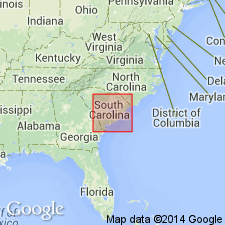
- Usage in publication:
-
- Rhems shale†
- Modifications:
-
- Abandoned
- AAPG geologic province:
-
- Atlantic Coast basin
Summary:
Black Mingo formation used to replace Sloan's (1908) Black Mingo phase. Extended to include all Eocene strata in South Carolina older than the McBean formation. Abandons Williamsburg pseudobuhr, Rhems shale, Upper Black Mingo, Lower Black Mingo, and Lang Syne beds, all part of the phase. [Correlation chart in this report shows correlation of Black Mingo with Tuscahoma sand, but text (p. 42) states that species COELOHELIA WAGNERIA Vaughan and HAIMESIASTRAEA CONFERTA Vaughan occur in Black Mingo (known before only in Midway and Wilcox groups of Alabama) as does OSTREA ARROSIS Aldrich (known only to be in Nanafalia formation of Wilcox group. Text makes no mention of correlation with Tuscahoma.]
Source: GNU records (USGS DDS-6; Reston GNULEX).
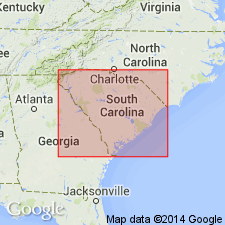
- Usage in publication:
-
- Rhems Formation
- Modifications:
-
- Reinstated
- Revised
- AAPG geologic province:
-
- Atlantic Coast basin
Summary:
The name Rhems, first defined by Sloan (1908) and abandoned by Cooke (1936), is reinstated as the Rhems Formation of the Black Mingo Group. Composed of fine to coarse arenaceous shales to argillaceous sands, and pelecypod-poor to pelecypod-rich clayey sand. Divided into Browns Ferry Member and Perkins Bluff Member. Composite stratotype of Rhems consists of outcrops at Browns Ferry and at Perkins Bluff. Type Rhems of Sloan (1908) is now only a member of a range of fine-grained clastics in Browns Ferry Member. Browns Ferry composite stratotype is the outcrop at Browns Ferry and underlying strata revealed in auger hole 15 ft away. Perkins Bluff stratotype is outcrop at Perkins Bluff on the Black River. Age of the Rhems is Paleocene (Midwayan, late Danian).
Source: GNU records (USGS DDS-6; Reston GNULEX).
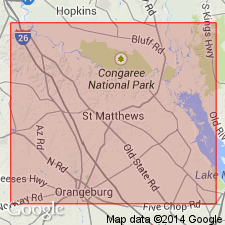
- Usage in publication:
-
- Rhems Formation
- Modifications:
-
- Revised
- AAPG geologic province:
-
- Atlantic Coast basin
Summary:
Sawdust Landing and Lang Syne Members of Rhems Formation formally named. Both previously were used informally by several workers. Considered updip correlatives of Browns Ferry and Perkins Bluff Members of the Rhems. Type sections given for both units, reference section provided for Lang Syne as original section is hard to access and is historically poorly defined. Report includes stratigraphic sections.
Source: GNU records (USGS DDS-6; Reston GNULEX).
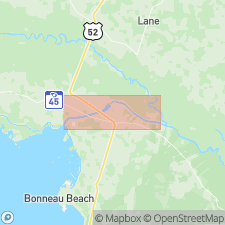
- Usage in publication:
-
- Rhems Formation*
- Modifications:
-
- Biostratigraphic dating
- AAPG geologic province:
-
- Atlantic Coast basin
Summary:
Dinocyst flora from the St. Stephens rediversion canal pit are sparse and poorly preserved but do give keys to the age of the Williamsburg and Rhems Formations in the Black Mingo Group. Dinocyst flora indicate an early Paleocene age for the Rhems Formation and suggest correlation with upper part of Clayton Formation or Porters Creek Formation, AL and GA, unit P1 of Prowell and others, 1985) in GA, and the Ellenton Formation of SC Coastal Plain. Samples are close in age to Brightseat Formation in MD. Equivalent to nannofossil zones NP 3 and 4. Dinocyst flora indicate a late Paleocene age for samples in the lower part of the Williamsburg Formation of the Black Mingo Group and late Paleocene or early Eocene(?) age for a sample from its upper part. Lower samples suggest correlation with Aquia Formation in MD and VA, the Nanafalia or Tuscahoma Formations in AL, and unit P2 of Prowell and others (1985) in GA. Equivalent to nannofossil zones NP 8 and 9. Dinocyst flora from upper part of Williamsburg correspond to late Paleocene species in Nanafalia Formation, but in Europe they would correspond to early Eocene.
Source: GNU records (USGS DDS-6; Reston GNULEX).
For more information, please contact Nancy Stamm, Geologic Names Committee Secretary.
Asterisk (*) indicates published by U.S. Geological Survey authors.
"No current usage" (†) implies that a name has been abandoned or has fallen into disuse. Former usage and, if known, replacement name given in parentheses ( ).
Slash (/) indicates name conflicts with nomenclatural guidelines (CSN, 1933; ACSN, 1961, 1970; NACSN, 1983, 2005, 2021). May be explained within brackets ([ ]).

